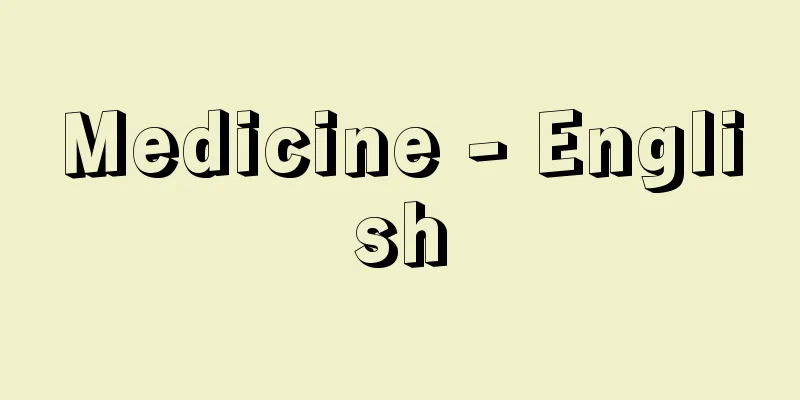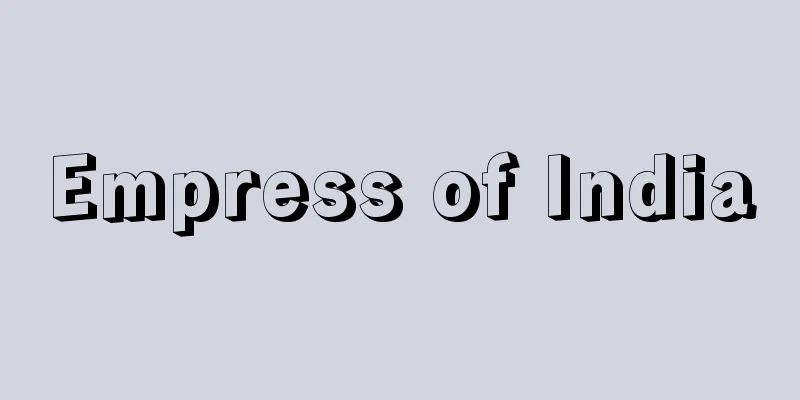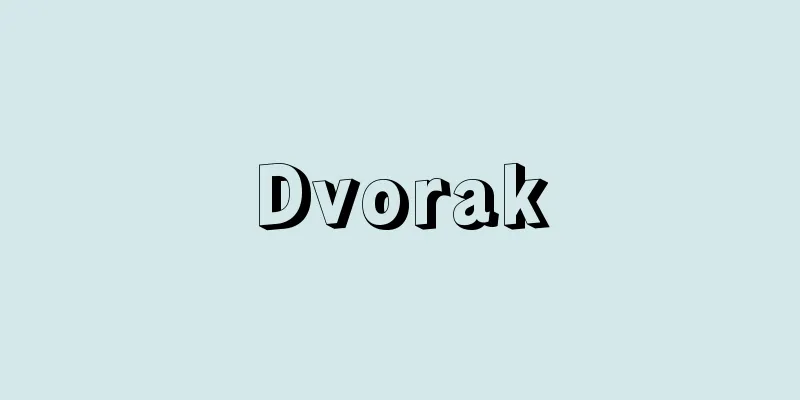Medicine - English

|
In Japanese, the word "medicine" can be used in two senses, broad and narrow, and the transition between the two is not always smooth. In the broad sense, medicine refers to the practice of medicine, while in the narrow sense, it refers to medicine as an academic discipline separate from practice. However, when medicine is expressed in European languages, there is no such distinction, and the academic part is not separate from practice. Taking this difference into account, if we were to define medicine in Japan, the following definition would be fairly general: "Medicine is a comprehensive science based on many natural sciences such as physics, chemistry, and mathematics, and is an advanced science whose ultimate goal is to elucidate the mechanisms of human life. Medical care is the social application of this medicine, and it can be said that medical care is the function required in the practical aspect of medicine, which is aimed at people, to care for their health when they are healthy, and to recover from health breakdown" (Takeuchi Yoshimi, 1971). In contrast to this, for example, in the United States, medicine is defined as "a complex of mutually supporting systems of knowledge, beliefs, skills, standards, values, ideologies, attitudes, habits and symbols..." (Sanders, L., 1954), and in Germany it is defined as "Medicine is a branch of human culture which aims to protect the health of individuals and groups, to help them recover from illness and reintegrate into society" (Rothschuh, K., 1965).However, in both cases, there is a strong tendency to understand medicine as a function of society or a branch of culture. What makes this even more striking is the difference in how medicine is positioned in the book classification tables of Japan and other countries. In the Nippon Decimal Classification (NDC), which was established and is used by the Japan Library Association, medicine is placed in the natural sciences (400), at the end of fields such as mathematics, physics, chemistry, earth science/geology, biology, botany, and zoology. On the other hand, in the Universal Decimal Classification (UDC), which is adopted worldwide, medicine is placed at the beginning (61) of the applied sciences/medicine/engineering/agriculture division, followed by classifications such as engineering and agriculture. It is true that medical research in Western medicine is also centered on natural science methods, but this is merely a method, and medicine itself is not considered to be natural science. This understanding of medicine in Japan is probably due to the fact that when Japan began to accept Western medicine, medicine showed a strong tendency toward natural science, and this tendency was thought to be the only thing that constituted medicine. Therefore, while in Western Europe, from around 1950, social science and humanities methods have gradually come to occupy a wider position in medicine in order to deal with illnesses more broadly and to reconsider medical methods themselves, there is no such movement in Japan because we are bound by the definition of medicine that we ourselves created. Based on the above premise, the composition of medicine in the narrow sense in Japan is currently classified into the following four categories: basic medicine, clinical basic medicine, clinical medicine, and social medicine. Each of these categories will be explained below. [Yonezo Nakagawa and Akira Nakagawa] Basic MedicineBasic medicine is further divided into several fields. One of these, anatomy, is called morphology in biology, but is traditionally called anatomy in medicine. In response to the general historical recognition that modern medicine began with the revival of human anatomy, anatomy is considered the most basic of the basics. Furthermore, anatomy is customarily divided into histology, which describes the morphology and structure of tissues, cytology, which describes the structure of cells, and embryology or embryology, which describes the morphology and structure of development. Furthermore, physical anthropology, which describes the variation of human form as a whole and infers lineage, is sometimes included in anatomy. Next is physiology. Physiology is an independent field that has derived from anatomy. In other words, physiology was once called "living anatomy" because the study of structure itself explains function. To explain their functions, further research into the substances and energy that make up their structures is necessary, and these studies are often called medicinal chemistry because they rely heavily on chemical methods, or biochemistry because of their relationship to life in general, and are thus branched off from and independent of physiology. Also, since around 1950, elucidation at the molecular level has progressed rapidly, and biochemistry has grown into a large field, so the term molecular biology has also become common. In addition to these, genetics and basic radiology, which studies the effects of radiation on living organisms, are also classified as basic medicine, but genetics and other fields are sometimes collectively referred to as human biology. [Yonezo Nakagawa and Akira Nakagawa] Clinical Basic MedicineThe term "clinical basic medicine" is relatively new. In the past, this was also included in basic medicine, but it has come to be treated separately because it is particularly related to clinical medicine. First, there is pathology. Pathology describes the morphological changes caused by disease, and was also called pathological anatomy, but it is often called pathology together with experimental pathology, which investigates the cause of disease. Just as basic medicine has physiology and biochemistry in addition to anatomy, pathology may also be called pathological anatomy, pathophysiology, and pathophysiology. In modern medicine, the cause of disease has been particularly heavily influenced by microorganisms such as bacteria and viruses, so bacteriology and microbiology occupy a position at the center of clinical basic medicine as independent sciences. When the immune phenomenon was revealed during research into the relationship between microorganisms and the human body, the significance of serum came into the spotlight, and each of these became immunology and serology, establishing their own independent fields. Medical zoology has also developed in order to learn about the behavior of various animals that are vectors of infectious diseases. The science of drugs is generally called pharmacy, but since medicine pays particular attention to the effects of drugs, it is called pharmacology. Since around 1970, there has been a demand to study the effects of drugs on humans, especially on sick people, and the field of clinical pharmacology has opened up, which can be said to be on the border between clinical basic medicine and clinical medicine, or a field that spans both. [Yonezo Nakagawa and Akira Nakagawa] Clinical MedicineClinical medicine is classically divided into internal medicine and surgery. Internal medicine includes internal medicine, pediatrics, and psychiatry, while surgery includes surgery, orthopedics, ophthalmology, otorhinolaryngology, and dermatology. Dermatology is included in surgery because many of the skin diseases that were once treated by medical treatment required surgical procedures such as incision. However, in recent years, clinical medicine has become more and more specialized, with four main categories. First, there are categories based on the characteristics of the patient. Pediatrics and gynecology fall into this category, but geriatrics and adult medicine, which were created in the latter half of the 20th century, also fall into this category. Pediatrics, in particular, is an important part of the growth period, and there are many problems that require medical attention, so traditional categories such as pediatric surgery, pediatric ophthalmology, and pediatric psychiatry have been further developed to target children, resulting in the creation of new, more detailed fields. The second category is a category that was created because the disease itself is unique and poses major problems. These include venereal disease, tuberculosis, and psychiatry. The third type is the division based on organs or organ systems. Examples include ophthalmology, otorhinolaryngology, and dermatology, but since the 20th century, independent divisions have included urology, cardiology, respiratory medicine, gastroenterology, neurology, neurosurgery, thoracic surgery, and gastrointestinal surgery. The fourth principle is based on the uniqueness of the medical technology. These include plastic surgery, cosmetic surgery, obstetrics, radiology, and anesthesiology. Psychosomatic medicine and psychosomatic medicine use psychiatric methods to treat internal medical symptoms, so they can also be said to follow this division principle. The field known as behavioral medicine is also new. It aims to utilize behavioral science in treatment. [Yonezo Nakagawa and Akira Nakagawa] Social MedicineSocial medicine is sometimes included in basic medicine, but since 1960 it has often been classified separately. Examples of this field include hygiene, public health, forensic medicine, and medical law. Hygiene is the oldest in the lineage of social medicine. Initially, hygiene was established with the aim of clarifying the conditions for food, clothing, and shelter required to maintain health, and its methodology was often based on natural sciences such as physics and chemistry, so it is thought to have been positioned as basic medicine. However, research and investigation in hygiene is not conducted in laboratories like basic medicine, nor in clinics or hospitals like clinical medicine. In other words, research and investigation is not conducted in an environment isolated from society, but in the real environment in which people live. Taking public health as an example, its content directly studies the conditions in which people live in groups, and how government intervention in particular can affect health. Therefore, the classification principle of social medicine can be said to correspond to the classification of social environments. According to this classification principle, social medicine includes rural medicine, urban medicine, industrial medicine, school medicine, and ethnic medicine. In addition, when we look at research methods and problem-solving methods, it includes epidemiology, public health, preventive medicine, comprehensive medicine, and management medicine. In order to clarify that social medicine goes beyond illness and places emphasis on prevention and health maintenance, many scholars believe that it would be better to use the words hygiene or even health, rather than medicine, in the names of the aforementioned fields. For example, rural hygiene or rural health could be used instead of rural medicine. [Yonezo Nakagawa and Akira Nakagawa] Medicine and Social Sciences/HumanitiesAs it became clear that medical care and health are not independent entities in themselves, but are part of a social function, and as it became clear that ignoring this would make it impossible to develop medical care and health care in a desirable way, the need for social science research on medical care became apparent. From this new perspective, medical sociology was born. Medical sociology is sometimes used almost synonymously with social medicine, but its significance lies in the fact that it does not start from medical care and health care, but rather applies research methods developed in sociology to medical care and health care, and the effectiveness of this approach has been recognized. In medical sociology, the characteristics of patients and medical professionals, as well as their mutual relationships, are the subject of research. On the other hand, cultural anthropologists have focused on the fact that the definition of illness changes and the response to medical care differs in relation to culture, and a new academic position called medical anthropology is being established that focuses on the medical part of the field. Furthermore, as medical expenses become a significant proportion of the social economy and a large portion of them are publicly funded, economic consideration of medical care becomes necessary. In this case, in the narrow sense, it means the management economics of medical facilities, but to distinguish from this, the term health economics is used to indicate the relationship with public economic policies. Furthermore, as the public nature of medical care is emphasized and the rights of those receiving medical care become fundamental, medical techniques that have previously been exercised based on the definitive judgments of medical professionals, especially physicians, will have to be publicly examined for the logic and ethics of the basis for those judgments. Medical ethics will require the construction of new theories, and there will be a need to logically or philosophically clarify the logic of medicine, particularly the medical decision-making process. Social sciences and humanities, which have previously only been considered as part of doctors' education, are now attracting urgent attention in their direct connection to medical care, and are being studied and institutionalized as new scientific fields. [Yonezo Nakagawa and Akira Nakagawa] Medical EducationThe structure of medicine described above is based on the principles of the classification of medical education subjects established in Germany in the first half of the 19th century. Here, we will explain medical education in Japan while touching on medical education in Germany and other countries. Medical education in Germany in the 19th century was promoted under the slogan of the three freedoms that were the principles of modern German universities: freedom to teach, freedom to learn, and freedom to research. In other words, professors could talk about anything in their lectures, students could listen to lectures by any professor at any university, and research was given the highest priority at universities. Medical students could become doctors if they attended lectures by the professors of their choice at the university of their choice and passed two national examinations in basic medicine and clinical medicine, but after graduation, they could only establish their status in medical society by participating as research students in the professors' courses of their choice, engaging in research, and receiving a degree. Japan introduced this German system of medical education in 1869 (Meiji 2), but the freedom to learn was restricted, and there was little freedom to move freely between universities or to choose from a wide variety of courses. However, there was more interest in obtaining a degree after graduation. According to a survey by the Ministry of Education (now the Ministry of Education, Culture, Sports, Science and Technology), the total number of people who obtained doctoral degrees under the old system, which continued until 1962 (Showa 37), was 89,857, of which 69,672, or 78%, were medical doctorates. Even since then, the number of people who have obtained doctoral degrees has remained at 50%, far exceeding the number of people obtaining doctoral degrees in other fields. After World War II, the influence of American medical education became greater, especially at the suggestion of the American Occupation Forces. A characteristic of American medical education is the emphasis on clinical education, that is, on practical training rather than lectures. In many medical schools in the United States, after students complete the basic medicine and clinical basic medicine stages, they are assigned to teaching hospitals and undergo ward training in several core subjects for a certain period of time. In other words, the principle of education is to allow students to accumulate learning as clinical physicians through experience, and lectures on clinical medicine are rarely given in lecture halls, as in Germany and Japan. In the United States, students do not have the freedom to move between universities as freely as in Germany in the past, but each medical school offers classes that allow for a variety of choices. In addition, after graduating from medical school, students undergo an internship to train in basic skills and attitudes as a physician, and then a period as a resident (ward doctor) to train as a specialist, and then a course is set up in which students become specialists by taking a certification exam from a specialist society. Medical research is also centered on clinical research, and laboratory research, as in Germany and Japan, is usually conducted mainly by students from other faculties. After World War II, the first thing Japan adopted in American-style medical education was the internship system, but the purpose of this system was not understood and dissatisfaction grew, leading to its abolition in 1968. In addition, hospital ward training was introduced in medical schools, and was strengthened considerably for a time, but it did not go as far as dramatically reducing lectures on clinical medicine in lecture halls, as in the United States. After World War II, the demand for medical care increased rapidly in every country, and the shortage of doctors became evident. In response, many countries expanded their medical schools. In Japan, during World War II, a large number of medical schools were built to train military doctors, but the country was defeated before it could produce many graduates. For a while after the war, there were many military doctors who had returned from the war, and it was decided that there would be no shortage of doctors for the time being, so a policy was adopted to streamline the medical schools that had been built during the war. However, after all citizens were required to join the health insurance system in 1959, the supply and demand of doctors, which had been thought to be relatively abundant, suddenly became tight, and in 1971, the government decided to expand again. The goal at that time was to "calculate the number of doctors required in 1968 using the relative ratio of the number of doctors to the number of patients in 1960 as a tentative standard, and to ensure that there were 150 doctors per 100,000 people by 1985." The year before this expansion, there were 46 medical schools, with 4,360 students (capacity), enrolled. As a result of this policy, the number of students increased to 8,340 in 1981, and the aforementioned target was almost achieved by 1983. In 1983, there were 79 medical schools, and 80 schools if the National Defense Medical College, which was established in 1974 to train medical personnel for the Self-Defense Forces, was included. However, since then, no new medical schools have been built, and instead, the capacity of many medical schools has been reduced, and by 1997, the number of students was 7,730. The background to this was the judgment of the Ministry of Health and Welfare (now the Ministry of Health, Labor and Welfare) that the number of doctors needed to be reduced in order to reduce medical expenses. The Japan Medical Association has pointed out that the physician sufficiency rate is too low compared to Europe and the United States, but the Ministry of Health and Welfare has consistently said that the number of doctors is sufficient, and that the problem is the regional distribution of doctors, that is, their concentration in urban areas. It is true that the geographic distribution of doctors is concentrated in urban areas and cannot be said to be appropriate, but the problem does not end there. Around 2000, cases of death from overwork among interns began to become evident, and many doctors suddenly quit public hospitals. Ambulances could not find a place to take pregnant women with cerebral hemorrhages. The exhaustion of doctors in the field due to the shortage of doctors became a social problem, and the term "collapse of the medical system" was started to be called. In 2007, the government finally changed its view that the number of doctors was sufficient and switched to a policy of increasing the number of doctors being trained (the number of students in medical schools for 2009 was significantly increased to 8,486). Furthermore, in 1994, the aging rate exceeded 14%, and changes in the disease structure, such as an increase in chronic diseases, have forced changes in medical education. The direction that is required is the improvement of holistic medical skills that are rich in humanity and skilled in clinical techniques. As an attempt to achieve this, the 1991 outline of university establishment standards allowed each medical school to independently organize their own curriculum. Traditionally, clinical medicine in Japan was generally taught in lecture format, and compared to Europe and the United States, clinical training tended to be neglected. In 1991, restrictions on medical practice by medical students were relaxed, and there were high hopes for this, but there were many obstacles, such as a shortage of teaching staff and the difficulty of knowing how students would be treated in terms of health care if they were allowed to perform medical procedures. Since 1997, the National Medical Licensing Examination has included compulsory questions on essential matters for doctors, such as medical ethics and primary care (primary medical care consisting of diagnosis and related medical care), and a higher rate of correct answers is required than questions in other fields. However, many people believe that the multiple choice format of the exam limits the ability to select the necessary qualities for a doctor, such as personality and insight. As mentioned above, after the internship system was abolished in 1968, the clinical training system was introduced in the same year, and doctors were required to strive to complete more than two years of clinical training after graduation, but this was merely a voluntary regulation. Moreover, the details of the training content were not determined, so many doctors ended up staying in university medical departments, which have many elements of an apprenticeship system. As a result, it was pointed out that training in primary care and emergency treatment was insufficient. In 2004, the new medical clinical training system was enacted, and doctors who wish to practice medicine were required to complete more than two years of clinical training. The content is also specified in detail, and trainees must rotate through internal medicine, surgery, emergency departments (including anesthesiology), pediatrics, obstetrics and gynecology, psychiatry, and community health and medical care. In principle, it is recommended that trainees spend at least six months in internal medicine in the first year, and the rest of the time in surgery and anesthesiology. This new system was designed to develop basic clinical skills as a doctor, but from the perspective of the doctors who supervise them on the ground, training trainees has become even more excessive work than before, and the number of doctors quitting due to exhaustion is increasing, which could be said to be accelerating the collapse of medical care mentioned above. [Yonezo Nakagawa and Akira Nakagawa] Problems in modern medicine and future challengesThe development of science and technology is more or less a double-edged sword. In the case of medicine, in particular, problems tend to become acute because it directly affects life. First, the problem with transplant medicine is that the definition of death had to be redefined because the organs of the donor (transplant organ donor) must be fresh. In other words, the prerequisite for this was the widespread use of the concept of brain death, which gave rise to many ethical issues. In 1967, the world's first heart transplant was performed in South Africa, and the following year, the US Harvard University announced the "Definition of Irreversible Coma," a brain death criterion. In Japan, a heart transplant was performed at Sapporo Medical University in 1968, which sparked a major debate about organ transplants from brain-dead individuals, but the debate died down. After that, the Organ Transplant Law was enacted in Japan in 1997, and full-scale transplant medicine was planned, but it cannot be denied that it was a hasty start without sufficient ethical discussion. Secondly, reproductive medicine, including artificial insemination, has inherent dangers in the technology itself, which allows the artificial manipulation of life at birth. The ability to artificially create genetically superior children through reproductive medicine will lead to an increase in children who are genetically specialized in the uniform abilities that society desires. This will reduce the inherent diversity of nature. Less diversity will lead to the weakening of the species. As medicine advances, many powerful medical treatments have been invented. These must have been attempts to control illness. However, medicine cannot answer the question of how far control is acceptable. For example, it is fine to treat depression, but is it acceptable to control existential worries as well? Pain control is important, but would there be any problem with avoiding danger if there was no pain? The boundaries between these are unclear. Modern medicine has made remarkable progress based on biological science, and has positioned medical treatment as its application. Its effectiveness and excellence in treating acute illnesses and trauma is unquestionable. However, it suddenly loses its effectiveness in treating chronic illnesses, neuroses, psychosomatic disorders, and other illnesses. This is because these illnesses are deeply connected to the subjective, and biological science, which aims to be objective, comes to a standstill. It is difficult to treat subjective things in an objective way. In the end, treatment focuses only on the parts of the illness that can be objectified, and the other parts are cut off. George Engel criticized the omnipotence of biological science in modern medicine and cited the fable "Procurtes' Bed." Procurtes is a thief in Greek mythology who would capture travelers and tie them to a bed he had prepared for them. If the traveler's legs were longer than the bed, he would cut them off, and if they were shorter, he would stretch them to make them the same length as the bed, which he enjoyed. Modern medicine also has a similar idea of cutting off parts that do not fit on the medical chopping block. Future medicine will have to be revised while facing various problems. [Akira Nakagawa] Nakagawa Yonezou, "Exploring Medical Awareness" (1975, Iryo Tosho Publishing) ▽ Yoshitoshi Kazu and Nakagawa Yonezou, "Introduction to New Medicine" (1977, Shinohara Publishing) ▽ Nakagawa Yonezou, "The Logic of Medical Procedures" (1980, Iryo Tosho Publishing) ▽ Nakagawa Yonezou, "Medical Clinic: For Healing Medical Care" (1994, Shinyosha) ▽ Nikkei Medical Editorial Department (ed.), "Medicine and Medical Care in the 21st Century - Proposals from 100 Japanese Basic and Clinical Scientists" (1995, Nikkei BP) ▽ Nakagawa Yonezou, "The Origin of Medical Care" (1996, Iwanami Shoten) ▽ Nakagawa Yonezou, "Uncertainty of Medicine" (1996, Nippon Hyoronsha) ▽ Ooi Gen, Horihara Hajime, and Murakami Yoichiro (eds.), "Principles of Medicine - The Humanity of Medicine" (1996, Kobundo) ▽ "Introduction to Medical Care," supervised by Hinohara Shigeaki (1997, Kenpakusha)" ▽ "The Dignity of Life: Medical Ethics in Japan, the United States, and Europe," edited by Hoshino Kazumasa (1999, Shibunkaku Publishing)" ▽ "Frontiers of Medical Sociology: Modern Medical Care and Society," edited by Kuroda Koichirō (2001, Sekaishisosha)" ▽ "Revised edition of Introduction to Medical Care, by Ebe Mitsuru, supervised by the Japan Society for Medical and Engineering Sciences (2002, Corona Publishing)" ▽ "Revised edition of Introduction to Medical Care, by Ebana Shoichi et al., supervised by Hinohara Shigeaki, edited by the National Council for Medical Secretary Education (2002, Kenpakusha)" ▽ "Introduction to Medical Care," by Goto Yoshio (2004, Bunkodo)" ▽ "Introduction to Medical Care/General Overview of Clinical Medicine," edited by the New Clinical Laboratory Technologist Education Research Group (2005, Ishiyaku Publishing)" ▽ "History of Medicine" by Akira Kajita (Kodansha Academic Library)" ▽ "The Current State of Medicine" by Fumimaro Takakuwa (Iwanami Shinsho) [References] | | | | | | | | | | | | | | | | | | | | | | | | |Source: Shogakukan Encyclopedia Nipponica About Encyclopedia Nipponica Information | Legend |
|
日本語で医学という場合、広義と狭義の二つがあり、しかも両者の間がかならずしも円滑ではない。広義の医学とは、医療の実践を示し、狭義の医学とは、実践から離れた学問としての医学を示すわけである。ところがヨーロッパ語で表現される医学の場合は、その区別がなく、学問の部分も実践から離れない。この差異を踏まえたうえで、日本での医学を定義するとすれば、次のような定義がかなり一般性をもつといえる。「医学は、物理、化学、数学等多くの自然科学を基礎とする総合科学であって、人の生命の機構を解明することを究極の目的とする高度の科学である。この医学の社会的適用が医療であり、人を対象として、健康時の健康養護、および健康破綻(はたん)からの回復を目的とした、医学の実践面に要求される機能が医療であるということができよう」(竹内嘉巳(よしみ)。1971)。これに対して、たとえばアメリカでは、「医学(メディシンmedicine)とは、全体として、知識、信条、技術、規準、価値、イデオロギー、態度、習慣、象徴など相互に支えあっている体系の複合であって……」(サンダースL. Sanders、1954)といった定義となり、ドイツでは、「医学(メディツィンMedizin)は人間文化の一分野で、個人および集団の健康を守り、病気を回復せしめて社会に復帰させるよう助力することを目的とする」(ロートシューK. Rothschuh、1965)という定義になるが、いずれの場合も、医学が社会の一つの機能や、文化の一分野として理解される傾向が強い。 それをさらに強く印象づけるのは、日本と外国の図書分類表における医学の位置づけ方の相違である。日本図書館協会が制定・使用している日本十進分類法(NDC)では、医学は、自然科学(400)のなかにあり、数学、物理学、化学、地学・地質学、生物学、植物学、動物学といったような分野が続いた最後に医学(490)が置かれている。一方、世界的に採用されている国際十進分類法(UDC)では、医学は、応用科学・医学・工学・農学区分のなかの初めの部分(61)に位置づけられ、以下、工学、農学などの諸分類が続いている。 確かに、欧米の医学においても、医学研究は自然科学的な方法が中心になって展開されているが、あくまでもそれは方法としてであって、医学そのものが自然科学であるとは考えられていない。日本における医学のこのような理解は、日本が西欧医学を受容し始めた時期に、医学が著しく自然科学的な傾向を強くみせていたために、その傾向のみを医学であると思ったためであろう。したがって、西欧では1950年ごろから、病気へのより広範な対処や医学的方法そのものの見直しのために、社会科学や人文科学的な方法が医学のなかでしだいに広い地位を占めるようになっているのに対し、日本でこうした動きがないのは、自らつくった医学の定義に、自らが拘束されているためである。以上のような前提のうえで、日本における狭義の医学の構成をみると、次の四つの分類が現在採用されている。すなわち、基礎医学、臨床基礎医学、臨床医学、社会医学の4分類である。以下それぞれについて解説する。 [中川米造・中川 晶] 基礎医学基礎医学はさらにいくつかの分野に分かれている。その一つである解剖学は、生物学では形態学とよばれるが、医学では伝統的に解剖学と呼び習わしている。近代医学は人体解剖学の復活から始まったという歴史的な認識が一般化していることに呼応して、解剖学が基礎中の基礎と考えられている。さらに解剖学は、組織の形態や構造を記述する組織学、細胞の構造を記述する細胞学、そして発生の形態や構造を記述する発生学あるいは胎生学を含むのが慣習である。さらに全体としてのヒトの形態の変異を記述して系統について推論する身体的人類学も、ときに解剖学に含められる。ついで生理学がある。生理学は解剖学の分科として派生・独立した分野である。つまり、構造を研究すること自体が機能の説明になるために、かつて生理学は「生きた解剖学」とよばれたことがある。機能を説明するためには、さらに、構造を構成する物質やエネルギーに向けての研究が必要であり、これらの研究は化学の方法に負う部分が多いために医化学とよばれたり、生命一般との関係を意識して生化学とよばれたりして、生理学から分派・独立している。また、1950年ごろから分子レベルでの解明も急速に進んで生化学などが大きな領域に育ったために、分子生物学という呼称も一般化している。これらのほかに、遺伝学や、放射線の生体への影響を研究する基礎放射線学なども、基礎医学に分類されているが、遺伝学などを総称して人間生物学とよぶこともある。 [中川米造・中川 晶] 臨床基礎医学臨床基礎医学という呼び方は比較的新しい。かつては、これも基礎医学のなかに含められていたが、とくに臨床医学と関係が深いものを別扱いにすることになったものである。まず初めに病理学がある。病理学は、病気による形態的変化を記述するもので、病理解剖学ということばもあったが、病因を追究する実験病理学とあわせて病理学といわれることが多い。基礎医学において解剖学のほかに生理学や生化学があったように、病理学においても病理解剖学、病態生理学、病態生化学という呼称が主張される場合がある。病気の原因について近代医学では、細菌やウイルスなどの微生物との関連がとくに大きく取り扱われてきたため、細菌学とか微生物学が独立した科学として臨床基礎医学の中心に位置を占めている。微生物と人体との関係を研究中に免疫現象が明らかになり、それに伴って血清の意義が脚光を浴びたところから、それぞれが免疫学や血清学となって独立の領域を確立している。また、感染症の媒介にあたる種々の動物の行動を知るために医動物学も育ってきている。薬に関する科学は一般には薬学といわれるが、医学では薬物の作用についてとくに関心を払うので、薬理学という。1970年ごろより、人間とりわけ病人への作用について研究することが求められるようになり、とくに臨床薬理学という領域が開けているが、これは臨床基礎医学と臨床医学との境界、あるいは両者にまたがる領域であるといえる。 [中川米造・中川 晶] 臨床医学臨床医学は古典的には内科系と外科系に分けられる。内科系としては、内科、小児科、精神科などがあり、外科系としては、外科、整形外科、眼科、耳鼻咽喉(いんこう)科、皮膚科などがある。皮膚科が外科系に入っているのは、かつて医療の対象になった皮膚の病気の多くが、切開などの外科的な処置を要するものが多かったことによる。ところが最近では、内科系、外科系とは異なる、臨床医学の分科が盛んであるが、分科の原理を求めてみると、おおよそ次の四つになる。まず、患者の特性による分科がある。小児科とか婦人科などがこれにあてはまるが、20世紀後半に分科した老年科あるいは成人科などもこの原理に入る。とくに小児科では、成長期の重要な部分を占め、医療的配慮を要する問題も多いために、小児外科とか、小児眼科、小児精神科などと、従来の分科をさらに小児対象に関連させ、細かい新領域が生まれている。2番目は、病気そのものが特殊であり、しかも大きな問題を抱えているために生まれた分科である。性病科、結核科、精神病科などがこれである。3番目には、器官あるいは臓器別の分科がある。眼科、耳鼻咽喉科、皮膚科などがそうであるが、20世紀になってから分科独立したものとして、泌尿器科、循環器科、呼吸器科、消化器科、神経内科、脳神経外科、胸部外科、消化器外科などがある。そして4番目の原理としては、その医療技術の特殊性に由来するものがある。形成外科、美容外科、産科、放射線科、麻酔科などである。心身医学科や心療内科は、内科的な症状に精神医学的方法を用いるものであるので、やはりこの分科原理に従っているものといえよう。行動医学といわれる領域も新しい。これは行動科学を治療に役だてようとするものである。 [中川米造・中川 晶] 社会医学社会医学を基礎医学に入れることもあるが、1960年以降、別の分類にすることが多くなった。この領域に属するものとしては、衛生学、公衆衛生学、法医学、医事法学などがある。社会医学の系譜では衛生学がもっとも古い。当初、衛生学は健康を保持するための衣食住の条件を明らかにする目的で出発したものであり、しかも方法的には、物理学や化学などの自然科学的手段によることが多かったために、基礎医学に位置づけられたものと思われるが、衛生学の研究調査の場は、基礎医学のような研究室ではなく、また臨床医学のような診療所や病院でもない。つまりは、社会から隔絶された環境に研究調査の場があるのではなく、生きている現実の環境にその場があることとなる。公衆衛生を例にとっても、その内容は、直接的に人間が集団で生活している状況について、とくに行政的な介入によって健康にどのような影響を与えうるかを研究するものである。したがって、社会医学の分類原理は、まず社会的環境の分類に対応するものであるといえる。この分類原理に沿えば、社会医学には、農村医学、都市医学、産業医学、学校医学、民族医学などが含まれる。また、研究方法や問題解決の方法に注目すれば、疫学、公衆衛生学、予防医学、包括医学、管理医学などが含まれる。社会医学が、病気より前に出て、その予防や健康保持に重点を置くものであることを明確にするためには、医学ということばよりは、衛生学、さらには保健ということばを、前出のそれぞれの領域を示す名称につけるほうがよいと考える学者も多い。たとえば、農村医学にかえて農村衛生学あるいは農村保健という表現を使うわけである。 [中川米造・中川 晶] 医学と社会科学・人文科学医療や保健が、それ自体独立したものではなく、社会的な機能の一部であることが明らかになり、しかも、それを無視しては、医療や保健の望ましい展開は不可能であることが意識されるにつれて、医療の社会科学的な研究が必要視されてきた。この新しい観点から生まれたのが医療社会学である。医療社会学は、社会医学とほぼ同義に使われることがあるが、医療や保健から出発せずに、社会学で開発された研究手法を医療や保健に適用し、この有効性が認められたところに意義がある。医療社会学では、患者、医療者の特性およびその相互関係などが研究対象となる。また一方、文化との関連で、病気の定義が変わったり医療への対応が異なったりすることに文化人類学者が注目し、医療に関する部分を対象として医療人類学(メディカル・アンソロポロジー)という新しい学問的位置づけがなされようとしている。さらに、医療費が社会経済のなかで無視できない割合を占めるようになり、その大きな部分が公的な支出によるようになると、医療に経済学的な考察が必要となってくる。この場合、狭義には医療施設の経営経済学を意味するが、これと区別して、公的な経済政策との関連を示すときには保健経済学という語が使われる。また、医療の公的性格が強調され、医療を受ける側の権利が基本となると、これまでは医療者、とくに医師の結論的判断によって行使された医療技術は、その判断の根拠の論理性と倫理性が公開の場で検討されなければならなくなる。医療の倫理学は新しい理論構築が要求されるし、医療の論理学、とくに医療的意志の決定過程を論理的にあるいは哲学的に明らかにする必要が生じてくる。これまでは、ただ医師の教養としてしか考えられなかった社会科学、人文科学が、直接医療との関連で、緊急な関心を集めつつ、新しい科学分野として研究され、制度化されようとしているわけである。 [中川米造・中川 晶] 医学教育これまでに述べた医学の構成については、19世紀前半にドイツでつくられた医学教育の教科目分類の原則に基づいたものである。ここで、ドイツなどの医学教育に触れながら、日本の医学教育について解説する。 19世紀におけるドイツの医学教育は、ドイツの近代的大学の原則である教える自由、学ぶ自由、および研究の自由の三つの自由をスローガンに進められた。つまり、教授は講義で何を話してもよく、学生はすべての大学であらゆる教授の講義を聞くことができ、そして大学では研究がもっとも重視されたわけである。医学生は、望みの大学で望みの教授の講義を聞いて、基礎医学と臨床医学の二つについて行われる国家試験に合格すれば、医師になれるが、卒業後は、希望する教授の講座に研究生として参加し、研究に従事し、学位を受けることによって初めて、医師社会における地位を築くことができたわけである。 日本は、1869年(明治2)このようなドイツ医学教育のシステムを導入したが、学ぶ自由は制限され、大学を自由に移動すること、あるいは多様な講義のなかから望みのものを選択する自由はほとんど提供されなかった。ただし、卒業後の学位取得についてのみは、より関心の高いものとなった。文部省(現文部科学省)調べによると、1962年(昭和37)まで続いた旧制度における博士の学位取得者の総数は8万9857人で、そのうち6万9672人、78%が医学博士となっている。それ以降でも、取得者数は50%と、他の領域の博士取得者数をはるかに超えている。 第二次世界大戦以降は、とくにアメリカ占領軍の示唆で、アメリカ型の医学教育の影響が大きくなった。アメリカ型教育の特徴は、臨床教育の重視、つまり講義よりも実地を重視することである。アメリカの多くの医科大学では、学生が基礎医学や臨床基礎医学の段階を終えると、教育病院に配属し、ある一定期間、いくつかの基幹となる科目についての病棟実習を行うこととしている。つまりは、臨床医としての学習を体験的に積み上げさせるのが教育の原則で、ドイツや日本のように臨床医学を講堂で講義するということは少ない。アメリカでは、かつてのドイツのように大学間を自由に学生が移動するという自由はないが、各医科大学には、多様な選択を可能にする授業が提供されている。さらに医学校卒業後は、医師としての基本的な技術や態度の研修を行うインターンを経たうえで、専門医としての研修を行うレジデント(病棟医)の期間を経験したのち、専門学会の認定試験を受けて専門医になるというコースを設けている。医学的な研究も臨床的な研究が中心で、ドイツや日本のような実験室での研究はおもに他学部出身者が行うのが普通である。第二次世界大戦後、日本がアメリカ型の医学教育のうちで、まず採用したのはインターン制度であるが、趣旨が理解されず、不満のみが高まって、1968年に廃止された。また、医学校における病棟実習も導入され、一時はかなり強化されたが、アメリカのように講堂における臨床医学の講義を大幅に減らす、というまでには至らなかった。 第二次世界大戦後、どこの国でも医療需要が急速に増加し、医師不足が顕在化した。これに対して多くの国で医学校の増設が行われた。日本では第二次世界大戦中、軍医を養成するために医学校の大増設を行ったが、多くの卒業生を出す以前に敗戦となった。戦後しばらくは復員軍医も多く、医師不足は当面ないという判断が生まれ、戦時中に増設した医学校を整理する方針をとった。ところが、1959年国民のすべてが健康保険に加入することになってから、比較的多いと思われていた医師の需給関係が急速に逼迫(ひっぱく)するようになり、1971年からふたたび増設に踏み切った。その時点での目標は、「昭和35年(1960)における医師数と患者数の相対的比率をいちおうの基準として、昭和43年(1968)における必要医師数を求め、人口10万人当り150人の医師数を昭和60年(1985)までに確保する」ことであった。この増設に踏み切る前年の医学校数は46で、4360人(定員)の学生が入学していたのが、この方針の結果、1981年には8340人にまで増加し、前出の目標も1983年にはほぼ達成という結果となった。1983年の医学校の数は79校、ほかに自衛官のための医療要員養成のために1974年に設置された防衛医科大学校を加えると80校であった。しかし、それ以後は医学校の増設はみられず、逆に多くの医学校で定員の削減が行われ、1997年(平成9)には学生数7730人となった。この背景には医療費を抑制するには医師数を抑制する必要があるという厚生省(現厚生労働省)の判断があった。日本医師会は医師充足率が欧米と比較して低すぎることを指摘してきたが、厚生省は一貫して医師数は充足しており、問題は医師数の地域的分布すなわち医師の都市部への集中であるとしてきた。確かに医師数の地域的分布において都市部への集中がみられ適正な分布とはいいがたいが、問題はそれだけにとどまらない。2000年ごろより研修医の過労死が顕在化し始め、公的病院から一挙に多くの医師が退職したり、脳出血を起こした妊婦の救急車の搬送先がみつからないなど医師不足による現場医師の疲弊が社会問題となるに至り「医療崩壊」という言葉が叫ばれるようになった。2007年政府はついに、これまでの医師数は充足しているという認識を変更し医師養成数を増加する方針に切り替えた(2009年度の医学部養成定員は大幅に増員され8486人となっている)。 また、1994年には高齢化率が14%を超え、慢性病の増加など疾病構造の変化に伴い医学教育も変化を迫られている。求められる方向性として、人間性豊かで臨床手技にも熟達した全人的医療能力の向上があげられている。その試みとして1991年の大学設置基準の大綱化に伴い、各医学校が自主的にカリキュラム編成を行うことができるようになった。伝統的に日本では臨床医学も講義で行う形式が一般的で、欧米と比較すると臨床実習がなおざりにされる傾向があった。そこで1991年には医学生の医療行為が緩和され大いに期待されたが、教育スタッフの不足や、学生に医療行為をさせた場合保健診療上どのような扱いになるのかむずかしいなど障害も多い。 医師国家試験では、1997年より医の倫理的問題やプライマリ・ケア(診断とそれに結び付く医療からなる第一次医療)など医師として必須(ひっす)の事項を必修問題として出題し、ほかの領域の問題より高い正答率が求められるようになった。しかし試験が多肢選択形式であるため、人格や識見など医師としての必要な資質を選抜するという意味においては限界があるという意見も多い。医師の臨床研修については、前述したようにインターン制度が1968年(昭和43)に廃止されてから、同年臨床研修制度が導入され、卒業後2年以上の臨床研修を行うよう努めるものとされたが、これは努力規定にとどまるものであった。しかも研修内容について詳しい内容は決められていなかったため結局は徒弟制度的な要素の多い大学医局に残る者が多かった。このためプライマリ・ケアや救急処置の研修が十分でないことが指摘されていた。2004年(平成16)、新医師臨床研修制度が制定され、診療に従事しようとする医師は、2年以上の臨床研修を受けねばならないとされた。内容も細かく決められ、内科、外科および救急部門(麻酔科を含む)、小児科、産婦人科、精神科および地域保健・医療をローテーション研修しなければならない。原則として当初の1年は内科を6か月以上、残りを外科および麻酔科で研修することが望ましいとしている。医師としての基礎的な臨床能力を養成しようとする新制度ではあったが、現場で指導する医師側からすれば研修医の指導はこれまで以上の過重労働となり、疲弊し辞めて行く医師も増加しており、先に述べた医療崩壊に拍車をかけているともいえる。 [中川米造・中川 晶] 現代医学の諸問題と将来への課題科学技術の発展は多かれ少なかれ両刃(もろは)の剣である。とくに医療の場合、直接生命にかかわってくるので問題は先鋭化しやすい。まず、移植医療においての問題点はドナー(移植臓器提供者)の臓器が新鮮であることが求められるため、死の定義をやり直さねばならなかったことである。すなわち脳死という概念の普及が前提となったため、多くの倫理的問題を巻き起こした。1967年に世界初の心臓移植が南アフリカで行われると、翌年には米ハーバード大学で脳死基準「不可逆的昏睡(こんすい)の定義」が発表されている。日本では1968年(昭和43)に札幌医大で心臓移植が行われたが、これを契機に脳死からの臓器移植について大きな議論が巻き起こったが立ち消えになっている。その後1997年(平成9)に日本では臓器移植法が施行され、本格的な移植医療が計画されているが倫理的議論が十分になされないままの見切り発車となっていることは否めない。 次に人工受精(人工授精)をはじめとする生殖医療は、誕生してくる生命を人工的に操作できるという技術そのものに危険性が内在している。遺伝的に優れた子供を生殖医療を通じて人工的につくれることは、社会が求める一元的な能力に遺伝的に特化された子供が増加することになる。すると自然が本来もっている多様性が低減する。多様性が少なくなることは種としての弱体化を招くだろう。 医学が進歩するにしたがって、多くの強力な治療法が発明されてきた。それは病気をコントロールしようという試みであったはずである。しかしどこまでコントロールしてよいのかという問題に医学は答えることができない。たとえばうつ病を治療するのはいいとしても、実存的な悩みまでコントロールしてしまっていいものだろうか。またペインコントロールは大事だが、痛みがなければ危険回避に問題はないだろうか。これらの境界はあいまいである。 現代医学は生物科学を基礎において著しい発展を遂げ、その応用として医療を位置づけてきた。確かに急性疾患や外傷に対しての有効性、卓越性は疑うべくもない。しかし、慢性疾患・神経症・心身症といった病気に対しては突如切れ味が悪くなる。なぜかというと、これらの疾患では主観が病気に深くかかわっていて、客観的であることを旨とする生物科学は立ち往生してしまうからである。主観的なものを客観的な方法で扱うことには無理が生じる。結局、病気の客観化できる部分にだけ焦点をあてた治療が行われることになり、その他の部分は切り捨てられることになる。 エンゲルGeorge Engelは現代医学の生物科学万能主義を批判して「プロクルテスのベッド」の寓話(ぐうわ)を引用している。プロクルテスというのはギリシア神話に出てくる盗賊で、旅人を捕まえては用意したベッドにくくりつけるのだが、旅人の足がベッドより長ければ切り落とし、短ければ引き延ばしてベッドと同じ長さに揃(そろ)えて楽しんだという。現代医学も同様に医学のまな板にのらない部分は切り捨てるという発想がある。今後の医学はさまざまな問題を抱えながら修正されていかねばならない。 [中川 晶] 『中川米造著『医療的認識の探究』(1975・医療図書出版)』▽『吉利和・中川米造著『新医学序説』(1977・篠原出版)』▽『中川米造著『医療行為の論理』(1980・医療図書出版)』▽『中川米造著『医療のクリニック「癒しの医療」のために』(1994・新曜社)』▽『日経メディカル編集部編『21世紀の医学・医療――日本の基礎・臨床医学者100人の提言』(1995・日経BP社)』▽『中川米造著『医療の原点』(1996・岩波書店)』▽『中川米造著『医学の不確実性』(1996・日本評論社)』▽『大井玄・堀原一・村上陽一郎編『医療原論――医の人間学』(1996・弘文堂)』▽『日野原重明監修『医療概論』(1997・建帛社)』▽『星野一正編著『生の尊厳――日米欧の医療倫理』(1999・思文閣出版)』▽『黒田浩一郎編『医療社会学のフロンティア――現代医療と社会』(2001・世界思想社)』▽『日本エム・イー学会監修、江部充著『医学概論』改訂版(2002・コロナ社)』▽『日野原重明監修、医療秘書教育全国協議会編、江花昭一他著『医療概論』改訂版(2002・建帛社)』▽『後藤由夫著『医学概論』(2004・文光堂)』▽『新臨床検査技師教育研究会編『医学概論・臨床医学総論』(2005・医歯薬出版)』▽『梶田昭著『医学の歴史』(講談社学術文庫)』▽『高久史麿著『医の現在』(岩波新書)』 [参照項目] | | | | | | | | | | | | | | | | | | | | | | | | | | | | | | |出典 小学館 日本大百科全書(ニッポニカ)日本大百科全書(ニッポニカ)について 情報 | 凡例 |
>>: Medical chemistry - ikagaku (English spelling) medical chemistry
Recommend
Gantillon, S. (English spelling) GantillonS
...Compared to the new plays (J. Renard, Courtrin...
Okinawa Cultural Association
... The period after World War II can be broadly ...
Keloid - Keloid (English spelling)
Also called crab podocarpus, this condition refer...
Surface chemistry - kaimenkagaku (English spelling) surface chemistry
A branch of chemistry that systems up the phenome...
Stanford-Binet test
...This mental age was taken to represent the lev...
Involuntary movement
What is the disease? Abnormal movements that occu...
Automatic loom with changeable bobbins
...A power loom that continues to operate by auto...
Theory of Depravity - Darakuron
A critical essay by Sakaguchi Ango. Published in S...
Huangfu
1880‐1936 Chinese soldier and politician. Born in ...
Horse New Year's Eve - Umanoto Toshikoshi
...It refers to the period from the evening of Ja...
Vinyl acetate
...The product made industrially from amyl alcoho...
Gǎn shàn de qīng (English spelling)
1546‐1622 A Huayan monk from the late Ming Dynasty...
Peterborough Chronicle
…The original was compiled in the late 9th centur...
(R)I P'il‐che
1825‐71 A leader of a peasant revolt in the late Y...
flotas
… (1) Trade management All ships going to the New...









